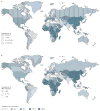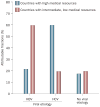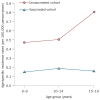Hepatocellular carcinoma: A global view
- PMID: 20628345
- PMCID: PMC3926946
- DOI: 10.1038/nrgastro.2010.100
Hepatocellular carcinoma: A global view
Abstract
Hepatocellular carcinoma (HCC) is a global health problem, although developing countries are disproportionally affected: over 80% of HCCs occur in such regions. About three-quarters of HCCs are attributed to chronic HBV and HCV infections. In areas endemic for HCV and HBV, viral transmission occurs at an early age, and infected individuals develop HCC in mid-adulthood. As these are their most productive years of life, HCC accounts for a substantial burden on the health-care system and drain of productive capacity in the low-income and middle-income countries most affected by HCV and HBV infections. Environments with disparate resource levels require different strategies for the optimal management of HCC. In high-resource environments, guidelines from the American Association for the Study of Liver Diseases or European Association for the Study of the Liver should be applied. In intermediate-resource or low-resource environments, the fundamental focus should be on primary prevention of HCC, through universal HBV vaccination, taking appropriate precautions and antiviral treatments. In intermediate-resource and low-resource environments, the infrastructure and capacity for abdominal ultrasonography, percutaneous ethanol injection, radiofrequency ablation and surgical resection should be established. Programs to provide targeted therapy at low cost, similar to the approach used for HIV therapy in the developing world, should be pursued.
Conflict of interest statement
The authors and the Journal Editor N. Wood declare no competing interests. The CME questions author D. Lie has served as a nonproduct speaker for “Topics in Health” for Merck Speaker Services.
Figures




References
-
- Ferlay J, et al. GLOBOCAN 2008, Cancer Incidence and Mortality Worldwide: IARC CancerBase No. 10. Lyon, France: International Agency for Research on Cancer; 2010. [online], http://globocan.iarc.fr.
-
- The World Health Organization. GLOBOCAN 2002. 2002 [online], http://www.emro.who.int/ncd/cancer_globocan.htm.
-
- McGlynn KA, Tsao L, Hsing AW, Devesa SS, Fraumeni JF., Jr International trends and patterns of primary liver cancer. Int J Cancer. 2001;94:290–296. - PubMed
-
- Armstrong GL, Alter MJ, McQuillan GM, Margolis HS. The past incidence of hepatitis C virus infection: implications for the future burden of chronic liver disease in the United States. Hepatology. 2000;31:777–782. - PubMed
Publication types
MeSH terms
Grants and funding
LinkOut - more resources
Full Text Sources
Other Literature Sources
Medical
Molecular Biology Databases
Research Materials

